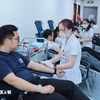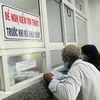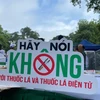 Public hospital services and products in 16 provinces and cities have become 18 percent more expensive since the middle of August. (Source: VNA)
Public hospital services and products in 16 provinces and cities have become 18 percent more expensive since the middle of August. (Source: VNA) Hanoi (VNA) – Public hospital services and products in 16 provinces and cities have become 18 percent more expensive since the middle of August, as patients pay for health staff’s basic salaries.
Labour-intensive services such as check-ups, bed charges and surgeries, particularly those requiring up to eight medical workers for three or four hours, cost more now.
Deputy Minister of Health Pham Le Tuan said the new tariff regime was for health insurance card-holders only and was being implemented in 16 localities where 85 percent of the population have bought medical insurance.
However, special medical insurance card-holders such as poor people, children under six years of age, social welfare beneficiaries and national revolutionary contributors such as Vietnamese heroic mothers and soldiers would not be affected by the increased rates as they were subsidised wholly or mostly by the government, he said.
The localities are Lao Cai, Thai Nguyen, Dien Bien and Ha Giang, besides Bac Kan, Son La, Tuyen Quang and Cao Bang, as well as Lai Chau, Yen Bai, Lang Son and Hoa Binh, as also Da Nang, Soc Trang, Thua Thien-Hue and Quang Nam.
In March this year, public hospital fees were hiked by 30 percent, with patients now having to pay for nearly 1,900 services and products that were earlier subsidised by the government, such as power and water, maintenance of equipment and waste treatment facilities and training and research.
When the first round of hikes took effect in March, the cost of a health check-up in first-class hospitals (national hospitals or major hospitals in cities/provinces/regions), for example, doubled to touch 40,000 VND (1.8 USD).
Bed charges per day went up from 80,000 VND (3.6 USD) to 215,000 VND (9.6 USD).
The cost of stomach flushing rose to 106,000 VND (4.7 USD) from 30,000 VND (1.3 USD).
According to finance and health ministries, this year would see three more hospital fee hikes in other localities in the country.
The fee revision is aimed at ending government subsidies in hospitals and at gradual improvement of the quality of health services.
Pham Luong Son, Head of the Vietnam Social Insurance Agency’s Health Insurance Policy Implementation Department, said the new prices would not apply to uninsured patients to give them time to buy insurance, but it would apply in the near future.
Uninsured patients would suffer the most with the rising prices, he said.
Around 71.1 million people, accounting for 77 percent of Vietnam’s population, had been covered by medical insurance as of the end of May. The country aims for 78.8 percent coverage by the end of this year and 90 percent by 2020.-VNA























